Comet Pan-STARRS thrills Dutch observers of the Night Sky on March 14, 2013 shortly after sunset- note the rich hues. Shot with a Canon 60D camera and Canon 100/400 mm lens, exposure time 2 seconds, ISO 800. Credit: Rob van Mackelenbergh
See viewing guide and sky maps below
Update – see readers photo below[/caption]
Comet Pan-STARRS (C/2011 L4) is exciting amateur astronomers observing the night sky worldwide as it becomes visible in the northern latitudes after sunset. And now it’s wowing crowds in Europe and all over Holland – north to south.
Check out the beautiful, richly hued new photos of Comet Pan-STARRS captured on March 14, 2013 by Dutch astrophotographer Rob van Mackelenbergh.
“I took these photos in the southern part of the Netherlands on Thursday evening, March 14, at around 7:45 pm Dutch time with my Canon 60 D camera.”
“I was observing from the grounds of our astronomy club – “Sterrenwacht Halley” – named in honor of Halley’s Comet.”
Comet Pan-STARRS is a non-periodic comet from the Oort Cloud that was discovered in June 2011 by the Pan-STARRS telescope located near the summit of the Hawaiian Island of Maui.
The comet just reached perihelion – closest approach to the Sun – on March 10, 2013. It passed closest to Earth on March 5 and has an orbital period of 106,000 years.
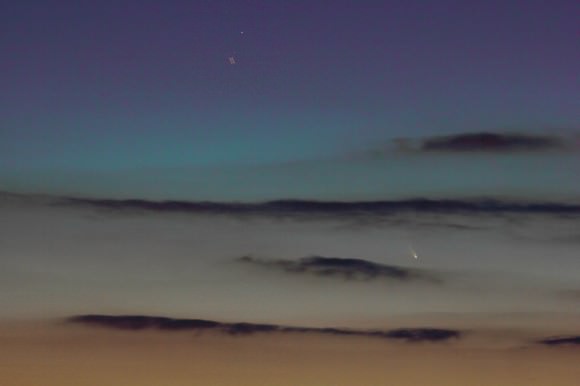
“Over 30 people were watching with me and they were all very excited, looking with binoculars and cameras. People were cheering. They were so excited to see the comet. But it was very cold, about minus 2 C,” said Mackelenbergh.
The “Sterrenwacht Halley” Observatory was built in 1987 and houses a Planetarium and a Celestron C14 Schmidt-Cassegrain telescope. It’s located about 50 km from the border with Belgium, near Den Bosch – the capitol city of southern Holland.
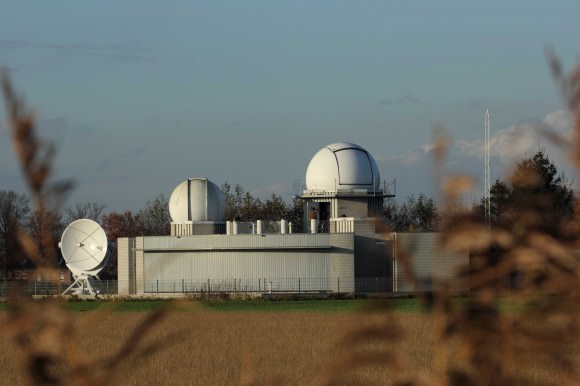
“It was hard to see the comet with the naked eye. But we were able to watch it for about 45 minutes altogether in the west, after the sun set.”
“The sky was completely clear except for a few scattered clouds near the horizon. After the comet set, we went inside the observatory for a general lecture about Comets and especially Comets Pan-STARRS and ISON because most of the people were not aware about this year’s pair of bright comets.”
“So everyone was lucky to see Comet Pan-STARRS because suddenly the sky cleared of thick clouds!”
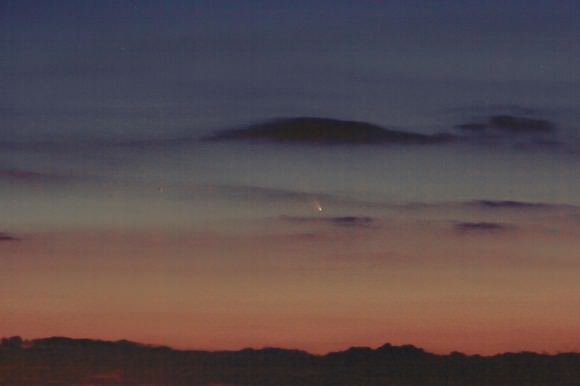
“In the past I also saw Comet Halley and Comet Hale-Bopp, but these are my first ever comet photos and I’m really excited !”
“I hope to see Comet Pan-STARRS again in the coming days when the sky is clear,” Mackelenbergh told me.
Over the next 2 weeks or so the sunset comet may grow in brightness even as it recedes from Earth into darker skies. Right now it’s about magnitude 0.2.
So keep looking with your binoculars; look west for up to 1 to 2 hours after sunset – and keep your eyes peeled.
And report back here !
See a readers photo of sunset Comet Pan-STARRS below
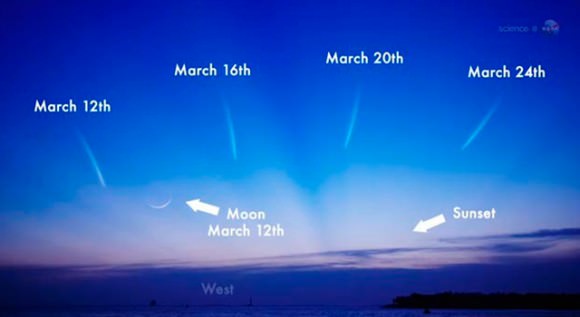


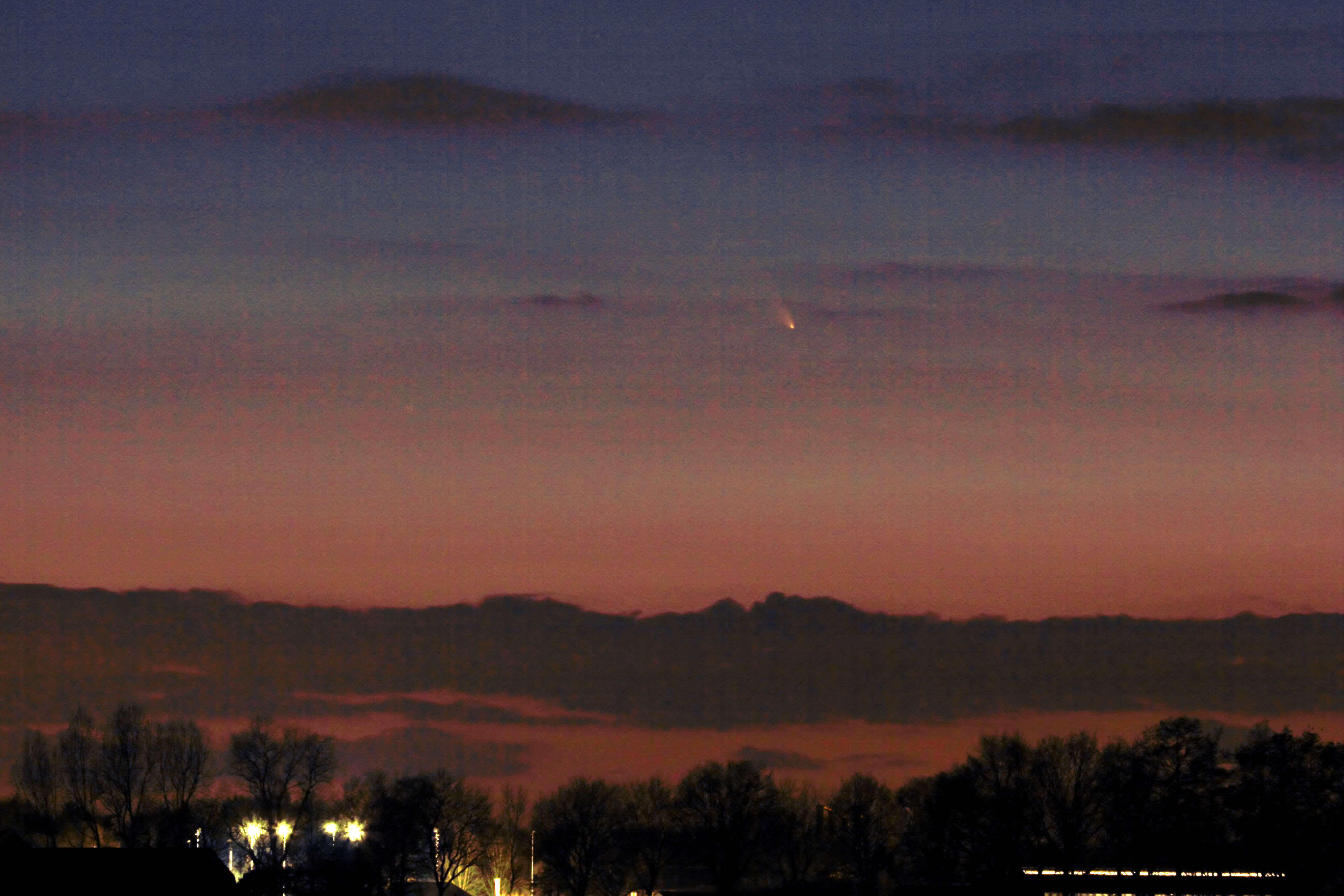
Im in the country, in Georgia ontop of a cow pasture hill, can see all directions clearly, no clouds, perfect weather, beautiful sunset and moon……..NO COMET ANYWHERE. What am I doing wrong? All of the “viewing graphics” that tell me the comet should be above the moon can’t be true. The only thing up there is Jupiter and a bunch of stars. Also the moon seems much higher in the sky than these graphics are showing. Can someone help me out?
hey man i was reading that these pan starrs are only visible in certain hemispheres, that may be your reason cuz i cant see any of them either
Thanks for the replies! I thought we could see it from all of the US but I guess not. If it was there to be seen, I would’ve seen it!
The comet is very dim. It was close to the moon on March 12 and 13 but not now. Now you have to look due west 30 minutes after sunset with binoculars and you should see it with your eye roughly 45 minutes after sunset. This website should help http://shadowandsubstance.com/march2013comet/Panstarrs.html
I can’t see it either. I think we must be too far south.
It is almost visible to the naked eye but nearly not quite. Use binoculars to help find.
Yes you can see it in Georgia as I saw it in San Antonio with city lights with binoculars. Forget about the moon- the comet was close on march 12 but not now. Scan with binoculars half hour after sunset above where the sun had set. Don’t expect more than a fuzzy line. Keep hand steady good luck
Hi PS
I have seen the comet three nights from the Florida Everglades. March 10, 13, 16
It is very low. It is fading as it moves farther from the Sun. The Moon is no longer useful as a guide. That was for one night only.
Watch the Sun set. Note where on the horizon this occurs.
About 40 minutes after sunset the comet will appear above and to the right of where the Sun set. The Comet will be about four finger widths above the horizon.
Clear skies
Another characteristic photo of comet PANSTARRS in the sky above Holland is the one André van der Hoeven made, with the typical Dutch windmills in the foreground: http://www.astro-photo.nl/wp_astro/wp-content/uploads/2013/03/panstarrs_over_Kinderdijk_1.jpg
Fantastic indeed!
outstanding view above the windmill !!
Three attempts and three failures.. dzzzzz. LAST NIGHT, looked good, so I went out to the coast to get a clear horizon view. There was a marine layer/foggy down near the water. It was super windy and very cold… will try again tonight!
An “A” for effort and persistence. keep trying !!
Thanks Ken! But the WX is NOT looking good tonight at this point.- stupid clouds!
This thing reminds me of Kohoutek. Pretty much invisible. I hope the one in November lives up to the hype. Give me Hale-Bopp any day!
Just a tip: our country is not called Holland. It’s called The Netherlands. Whenever you hear / see Holland, redirect to this video explaining all: http://www.youtube.com/watch?v=eE_IUPInEuc – I haven’t been able to capture it, but maybe later this week 🙂
Do you live in Holland or Netherlands if you know what I mean 🙂
I live in The Netherlands, in the province known as South-Holland. If you know what I mean 😉